Whether you have a foyer, a mudroom off your garage, or a table by the door, everyone needs an entry area. It’s the place you store your keys and take off your shoes. It’s the spot you put things when you don’t want to forget to take them with you when you run errands. This week in the Organized Life Series, we’re going to organize the entry area.
There are certain things that you always take with you when you leave every day:
- Keys
- Shoes
- Phone / Electronics
- Handbag / Wallet
- Briefcase / Backpack
- Irregular Items
It’s important to keep those items handy so that they don’t get lost or forgotten. You need a system for organizing these things and develop habits around those systems.
Keys
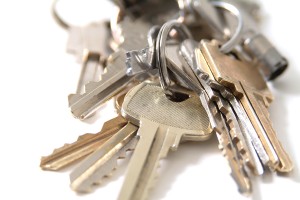 If you have ever lost your keys or know anyone else that has done so, you know what a hassle that can be. That problem is easily solved by always putting your keys in the same place when you walk in the door. Don’t put them in your pocket or your bag. There are 2 great solutions for organizing you keys.
If you have ever lost your keys or know anyone else that has done so, you know what a hassle that can be. That problem is easily solved by always putting your keys in the same place when you walk in the door. Don’t put them in your pocket or your bag. There are 2 great solutions for organizing you keys.
1. Hang them up. You can get great entry organizers with whiteboards, magnets, mail slots, key hangers and more. Or you can just get a cheap screw-in hook at the hardware store and screw it into the wall. (Note: put it in the stud or get a drywall anchor. That hook is going to take a beating.)
2. Put them in a bowl. If you have an entry table, place a bowl on it for keys. You can get something fun and cute, or just use a bowl from your kitchen.
Whatever you choose, make sure you adjust your habits accordingly. ALWAYS put your keys in the allocated space.
Shoes
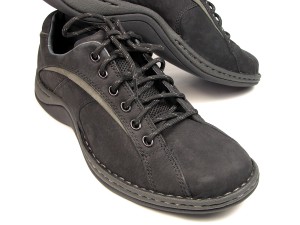 Most people don’t like to wear their street shoes through the house to potentially ruin carpet. Some people wear slippers in the house and some don’t. (Those of us that have concrete slab foundations typically wear them in the winter, at least.) You may keep most of your shoes in your bedroom closet, but you probably need at least a pair of sandals or loafers to slip on quickly to run out and get a package or check the mail. And you probably keep a pair of sneakers handy for daily wear. That can lead to a potential problem. Shoe clutter and shoe smell. How you should organize them depends on your space.
Most people don’t like to wear their street shoes through the house to potentially ruin carpet. Some people wear slippers in the house and some don’t. (Those of us that have concrete slab foundations typically wear them in the winter, at least.) You may keep most of your shoes in your bedroom closet, but you probably need at least a pair of sandals or loafers to slip on quickly to run out and get a package or check the mail. And you probably keep a pair of sneakers handy for daily wear. That can lead to a potential problem. Shoe clutter and shoe smell. How you should organize them depends on your space.
Mud Room – if your home has a mudroom, this is an organizer’s dream. Cubbies for shoes and different family members. Throw some used dryer sheets or a sachet in the back of the cubbies to keep down the smell. When you kick off your shoes, put them in your cubby.
Garage – Smell isn’t much of a problem in a garage, and neither is organization. Put a small shoe shelf or a metal shelf next to your door and store your shoes. It’s not a bad idea to put a rubber mat or shelf liner on the shelf first. Make sure your most-used shoes go on the bottom shelf so you can kick them off there easily. And have a nice doormat by the door that you clean often so you don’t dirty your socks on the garage floor.
Foyer – If you have a foyer, you probably have a closet. Organize the bottom of it with a shoe shelf. Keep some sneaker spray handy and place some used dryer sheets or sachet in the closet to keep the smell down. You don’t want your nice ski jacket smelling like feet. If you have a foyer, you may even have a place you can keep 1 pair of shoes out. Be careful that it doesn’t get cluttered with several pairs of shoes, though.
Hallway with a table – if you have this small of a space, you probably don’t have a large family, so keeping 1-2 pairs of shoes under that table (on a rubber mat) and keeping the rest in your bedroom closet shouldn’t be a problem.
None of the Above – My first home had a square of vinyl floor where the front door was and entered straight into the living room. I had a coat tree behind the door and put down a plastic mat and a shoe shelf next to it. Whatever your space, organize around your life.
Phone / Electronics
 These days everyone has at least one mobile device. Even the kids. There are two types of phone users – casual and heavy. Casual users have small phone plans with little or no data and use their phones when their away from home. Their normal phone and data usage at home is done on a land line or on their computers. The heavy user is very attached to their phone. Their main form of communication is probably texting and they like to have their phone within arms reach at all times. The problem for both users is losing or forgetting their phone. (Disclaimer – there is a range between these 2 extremes, but choose whichever you are closer to.)
These days everyone has at least one mobile device. Even the kids. There are two types of phone users – casual and heavy. Casual users have small phone plans with little or no data and use their phones when their away from home. Their normal phone and data usage at home is done on a land line or on their computers. The heavy user is very attached to their phone. Their main form of communication is probably texting and they like to have their phone within arms reach at all times. The problem for both users is losing or forgetting their phone. (Disclaimer – there is a range between these 2 extremes, but choose whichever you are closer to.)
Casual User – The best solution for the casual user is to have a docking station or charger near your keys. Whether in the entry or on the kitchen counter, you want to make sure that when you leave the house, your phone is fully charged and not left in your bedroom where you could forget it. Pick 1 or 2 places in your home (entry and bedroom, for example) and create 2 charging stations so you’ll never forget your phone.
Heavy User – When you carry your phone with you from room to room, you stand a greater chance of losing it. The solution is to be consistent. Make sure there is one place in every room that you place your phone. And when you go to that room, that is the ONLY place you put it. Always put it in the same place on your kitchen counter or desk. Always place it on your nightstand or side table in your bedroom or family room. If you realize you don’t have your phone with you, it’s easy to walk from room to room and look in ONE place in each room. You’ll find your phone quickly. You probably want to have chargers available in your most-visited rooms – bedroom, family room, office.
If you’re trying to simplify your charging process, you could get a charging mat. You don’t have to plug in your phone. Just place it on the mat and forget it. Although, those products aren’t getting the best reviews unless you spend over $100 for one. Another good solution is to get something pretty that you don’t mind having sitting out.
This $25 grass charging station hides the cords for your devices, for example.
Handbag / Wallet
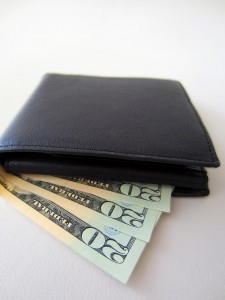 The theme here is consistency. The goal is to make sure that you’re always putting things in the same place so you don’t forget them when you leave. Picking them up is part of your habit.
The theme here is consistency. The goal is to make sure that you’re always putting things in the same place so you don’t forget them when you leave. Picking them up is part of your habit.
Wallet – Whether you take out your wallet when you get home and put it in a drawer or keep it in your pocket until you change clothes at night and then put it on your dresser, set your habits so you never forget your wallet. Don’t keep it in your coat pocket if you don’t usually do that. Don’t deviate from your normal habits: that’s how you’ll lose your wallet. Also, if you drive or sit a lot, try not to keep your wallet in your back pocket while doing so. It’s bad for your back. And if you’ll be walking through a lot of foot traffic where you could be mugged, make sure your wallet is secure.
Change – Although a lot of purchases these days are made using credit and debit cards, we do still pay cash for some things. That leads to the accumulation of change. Whether in the pocket of guys’ pants or in women’s wallets, you need a system for your change. Some people like to save it up to cash in a couple times a year for vacations or Christmas gifts. Whatever you do, make sure there is one place in the house for that change. It can be in your office or your bedroom or even in the kitchen. The goal is to have a spot somewhere convenient to empty pockets and wallets when they get weighted down. Use a bowl with a lid or a jar. Use a piggy bank if you like. Make it something easy to carry that won’t spill in the car when you take it to the change machine in the bank. And don’t use the stupid coinstar machine that charges you a fee. My credit union has a machine that’s free for members to use.
Handbag – The best solution is to keep your handbag in the entry where you can put it down (or hang it up) immediately upon arriving home and it’s near your keys and the last thing you pick up as you leave the house.
Briefcase / Backpack
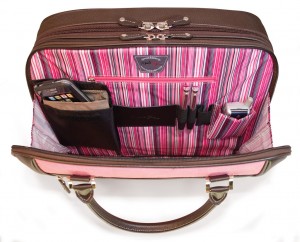 Depending on what you do for a living, you may carry a briefcase, backpack, or tote bag with you every day with your laptop, tablet, and some papers. Maybe you’ve gotten to work a few times and realized you left your bag at home. One commute is bad enough. Making it twice needs to be avoided. Make some habits that help you be more organized.
Depending on what you do for a living, you may carry a briefcase, backpack, or tote bag with you every day with your laptop, tablet, and some papers. Maybe you’ve gotten to work a few times and realized you left your bag at home. One commute is bad enough. Making it twice needs to be avoided. Make some habits that help you be more organized.
1. Keep your bag in the entry. When you grab your keys, you can grab your bag (briefcase/backpack/tote bag). If you take things out of it that need to be replaced before leaving, leave the bag open. Then, when you go to leave that open bag is your signal to get the missing item. Remember that the entry is defined as where you keep your keys. It’s hard to leave without your keys.
2. Charge items immediately. As soon as you get home, take any electronic devices that need charged out of the bag and charge them. Again, if you take it out, leave the bag open. If you have multiple chargers for your devices, always keep one in the bag. If you don’t, head over to Amazon and get yourself a spare. It’s well worth $3 or so.
3. Keep the bag organized. About once a week, go through your papers and stuff that accumulates in your bag. It’s just a good habit.
Irregular Items
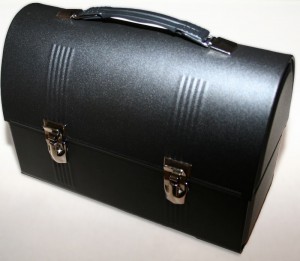 There are other items you may take with you every day such as a lunchbox or cooler. Other items you don’t take every day, but you may take regularly. Items such as a grocery list, coupons, reusable grocery bags, or dry cleaning fall under this category. And sometimes you need to take an item to loan to a friend or something related to an errand. You need a place to put these things in your entry area so you don’t forget them.
There are other items you may take with you every day such as a lunchbox or cooler. Other items you don’t take every day, but you may take regularly. Items such as a grocery list, coupons, reusable grocery bags, or dry cleaning fall under this category. And sometimes you need to take an item to loan to a friend or something related to an errand. You need a place to put these things in your entry area so you don’t forget them.
Lunch – This is simple. When you finish packing your lunch in the morning, put it near your keys.
Regular items – When you finish your shopping list and gather your coupons, put them in the entry. When you bring home groceries, place your empty shopping bags in the entry so they can go back to your car the next time you go out. When you have dry cleaning to go out, hang it in the entry or at least place a note there so you won’t forget to grab it.
Unusual items – the same process follows. A friend wants to borrow an item. Place it in the entry as soon as they ask (or as soon as you get your scheduled reminder) so you won’t forget it when you leave. If you need to take something out for repair or need to take an item for any reason, have a designated area for these items in the entry so you won’t forget them. It may be on a bench, on the stairs, or in the garage.
Again, make it a habit to put things in one place that need to go out to the car with you. Then it will be a habit to grab anything that’s there and you won’t forget it.
Make Good Habits
While the Organized Life Series is mainly about getting organized, it is also about creating good habits around that organization. After all, if you organize something and then don’t follow through with that organization, it becomes pointless. So keep up the good work and we’ll keep getting organized!





